Johnny Appleseed wasn’t quite a New England version of St. Francis, wandering the countryside in rags, scattering apple seeds and befriending woodland creatures.
Oh he did wear rags, he did love animals and he did bring apples to thousands of people. And he certainly roamed the newly settled frontier.
But he did it to make money selling apples for hard cider.
And Johnny Appleseed died a wealthy man.

John Chapman birthplace in Leominster, Mass.
Johnny Appleseed
Johnny Appleseed was born John Chapman in Leominster, Mass., on Sept. 26, 1774. You can hardly miss him if you visit the city. His birthplace has a granite marker and a billboard, streets and schools bear his name and a wooden statue of him stands in City Hall.
He only lived in Leominster a few years, though. His mother died when he was very young, and his father moved to Longmeadow, Mass., and remarried. Along came 10 half-siblings, and Johnny and a half-brother left the crowded house around 1796.
At that time, New England farmers began to head west in great number, looking for better soil and bigger farms. Life on the frontier wasn’t easy, and often farmers only had hard cider to quench their thirst for an alcoholic beverage.
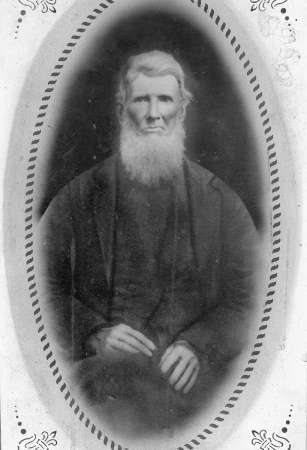
Photograph of John Chapman in the 1840s.
Johnny Appleseed saw his opportunity. He had a knack for predicting where the next wave of settlement would go, and he began to plant apple trees in anticipation of the next settlers.
He didn’t scatter seeds for orchards, but planted nurseries — in western Pennsylvania, Ohio and Indiana. Johnny Appleseed eventually traveled as far as Ontario, Illinois and West Virginia.
Once he planted his nurseries, he built fences around them. Then he hired someone to take care of them and returned every year or two to check on his trees. The caretaker sold seeds and saplings.
He wandered because he had to to buy up inexpensive land before the next group of customers settled the frontier.
Apples
The apple industry created the myth that Johnny Appleseed brought a healthful, delicious fruit to pioneer farmers.
In truth, his apples had one purpose, and it wasn’t to make pies and crumbles. Farmers could only make hard cider from them.
Johnny Appleseed’s apples didn’t come from grafted trees, but from seedlings. Henry David Thoreau once wrote that apples from seeds were “sour enough to set a squirrel’s teeth on edge and make a jay scream.”
Eight years before he died, the financial panic of 1837 took a toll on his wealth. Nevertheless, Johnny Appleseed died a rich man, owning more than 1,200 acres of prime real estate.
Bit of a Loon
Parts of the Johnny Appleseed myth do have elements of truth to them, though. He did dress in rags, sometimes even in old coffee sacks with holes cut in them for his head and arms.
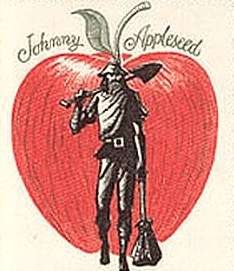
Stamp.
He did it because he followed the Swedenborgian religion, and believed that the more he suffered in this world the more happiness he would experience in the hereafter. According to his obituary, he ‘submitted to every privation with cheerfulness and content, believing that in so doing he was securing snug quarters hereafter.’
Johnny Appleseed often stopped in frontier cabins to spread ‘some fresh news from Heaven.’
According to Harper’s magazine, he once lingered to hear a longwinded preacher speak to a crowd of people from a stump he used as a lectern.
The preacher urged his listeners to give up extravagance.
“Where now is there a man who, like the primitive Christians, is traveling to heaven barefooted and clad in coarse raiment?” the preacher asked
Exasperated, Johnny Appleseed put his bare foot on the stump and said, “Here’s your primitive Christian!”
Folk Hero
Johnny Appleseed shared his trees with Native Americans during his travels, and converted some of them to his religion. They in turn taught him how to heal with herbs and plants, and even hostile tribes left him alone.
He had some other eccentric beliefs, which at least one biographer attributes to a kick on the head from a horse. For example, he thought it cruel to ride a horse or chop down a tree.
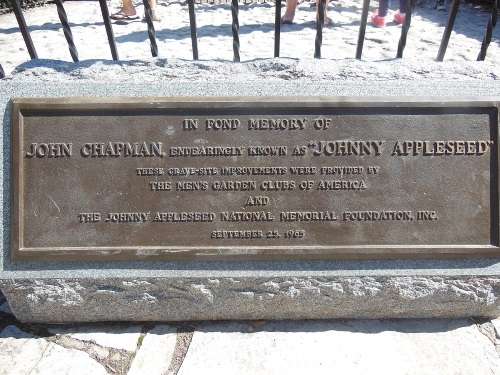
Gravesite of John Chapman.
He also liked to give ribbons to small girls and entertain small boys by walking on hot coals.
Eventually his travels brought him a reputation as a healer and a folk saint.
Johnny Appleseed died around 1845, though the exact date of his death is disputed. He left his valuable nurseries to his sister.
Today, an annual Johnny Appleseed Festival draws an average of 10,000 people – held in the fall, of course, around the time of the apple harvest.
Read more surprising apple history along with historic apple recipes in the New England Historical Society’s 29 Historic New England Apple Recipes. Available now in paperback.
With thanks to MassMoments. Image of Johnny Appleseed gravesite, By Rochelle Karp – Own work, CC BY-SA 3.0, https://commons.wikimedia.org/w/index.php?curid=21439692; Apples by By Leslie Seaton from Seattle, WA, USA – Newtown pippins, CC BY 2.0, https://commons.wikimedia.org/w/index.php?curid=33880381. This story was updated in 2023.

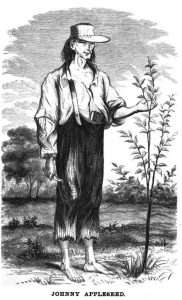
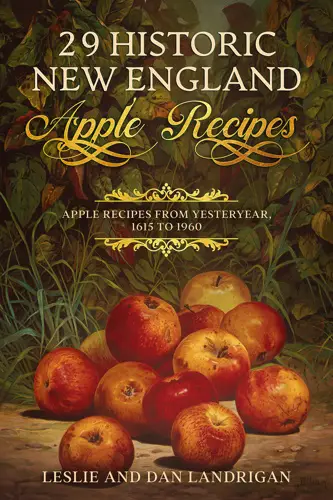
1 comment
Thank you for this humorous take on Johnny !
Comments are closed.